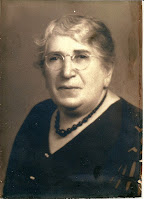 |
| Regina Bauer Rosenzweig |
Five years ago, my cousin Linda and I visited the cemetery in Kunszentmiklos Hungary. Our great-grandmother, Regina (Rivka) Bauer was born there. Her father too.
I remember my great-grandmother, who died when I was nearly three. She lived with our grandparents and used to give me M&Ms. She and her husband are buried at the Poale Zedeck cemetery in the Sheraden neighborhood of Pittsburgh. My grandparents and other family members are buried there as well.
There are dozens of Bauers buried in Kunszentmiklos including the parents of my great-grandmother and her brother, who is my father's namesake. But when Linda and I were there five years ago, it was badly overgrown and we could not see anything of use, although many of the stones themselves were in very good condition. I wrote about that visit as part of an eight blog series describing that trip.So here we were, Wednesday morning headed from our Airbnb in Dunaujvaros to Kunszentmiklos thirty-six km away, to meet Imre, the keeper of the key to the cemetery. They truly did an excellent job cleaning up the cemetery and making the existing 189 tombstones accessible to visitors, though it is not easy walking around.
By the way, all the Bauers are written בויער in Hebrew, pronounced Boyer.
 |
| The state of the cemetery - five years ago (above) and now (below). |
 |
| The whole foreground area and to both sides has signs of graves, but there are no tombstones. |
<
I had come with four goals in mind for this visit.
1. Visiting and photographing the graves of my known relatives.
2. Clarifying the source for my father's name.
3. Clarifying the name of my second-great-grandfather's mother.
4. Gathering whatever information I could about the many members of my great -grandmother's Bauer family.
My known relatives
I knew from cemetery records that my great-grandmother's parents and brother were buried in Kunszentmiklos. This would be Simon (Shemaya) Bauer (died 1902), Fani (Feige) Stern Bauer (died 1911) and Lajos (Eliezer) Bauer (died 1917).
I expected that my great-grandmother's older sister Ilona (Dobrisch) Bauer Wiesel (died 1893 at age 30) was also there because I have seen her death record. This even though I have not seen her in cemetery records.
Simon and Fanny are side-by-side, with Hungarian on one side and Hebrew
on the other. The Hebrew sides did not photograph well, because of
both the quality of the work and the direction of the sun. But I bring
it all here.
A bit later, as we were looking at some of the older, more difficult stones, I saw this, which Rona enhanced with a bit of water.
Wiesel Lipotne (Mrs. Lipot Wiesel)
Bauer Ilona
Age 30
Died 20 August 1893
The other side is in Hebrew. Here is a partial photograph.
The educated woman, crown of her husband
Pride of her family and beloved of her acquaintances
Plucked away in her youth, age 30
Mrs. Dobrisch
Dear to her husband Lipman Wiesel
From the Bauer family
Died 5 Elul 5653
Her mother's name is Feigele.
This is the eldest of Simon and Fani's children and Regina named her daughter Helen after her in 1896.
I shall address more of my Kunszentmiklos goals probably tomorrow.







Curious about the business with the cemetery being better kept. Did you have something to do with that? Perhaps I didn't see an earlier blog piece that discussed this.
ReplyDeleteThere is an organization that does this.
DeleteWe had a preliminary look at Apostag, which I'll discuss next week, which has a sign saying that the town's descendants restored the cemetery.